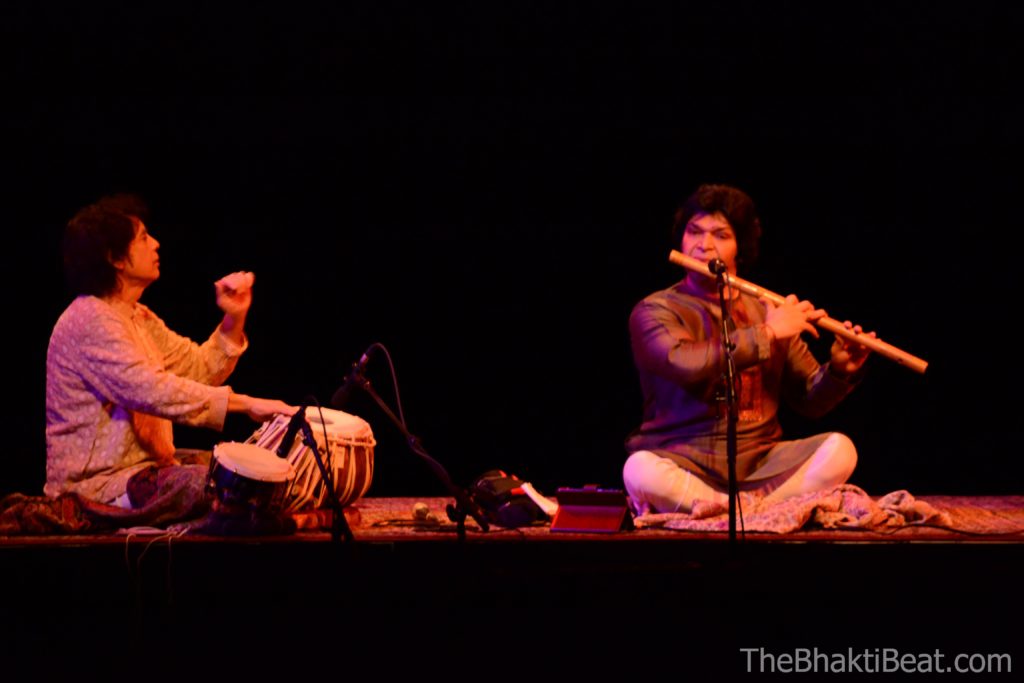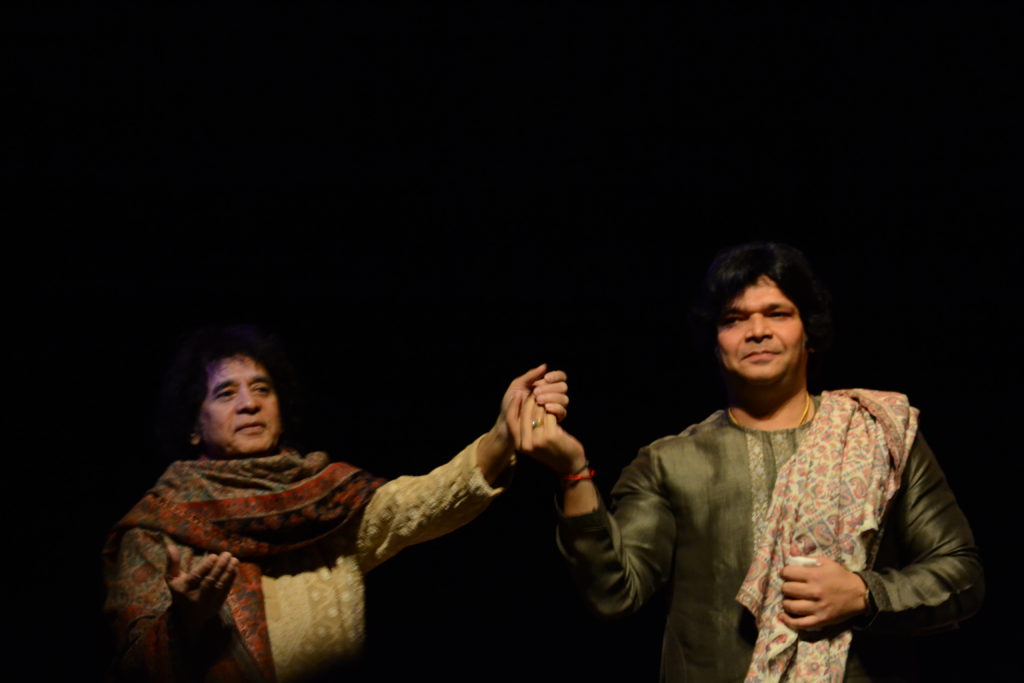Neuroscientists have found that the motor cortex of certain string musicians have exaggerated brain “maps” devoted to the left hand, a consequence of the hand’s repetitive handiwork along the fret. I suspect Zakir Hussain’s brain holds the maps for at least four very large and finely elaborated hands.
It seems impossible when listening to this tabla maestro that he doesn’t have four hands. Like a David Copperfield of drums, Hussain’s hands are in perpetual motion, often just a blur of flesh-toned ribbons that the human eye can’t quite catch up to. His performance at the Flynn Center for the Performing Arts March 19 with bansuri flute master Rakesh Chaurasia was a magic show of divine order. Hussain coaxed and caressed and cajoled a mind-boggling array of rhythms and riffs, blips and broops, tiks and taks, from the trio of tablas that sat before him like an altar. Appropriate, given that the evening was for all intents an offering to the Rhythm Gods.
It’s as if each part of this man’s hands is its own instrument: Fingers, thumbs, palms, heels of the hand — each part works on its own yet in perfect synchronicity with the others, producing a musical stew that defies the logic of what a single musician can do. Each hand, moreover, plays a distinct role in the composition, separate but perfectly merged in rhythm and timing.
But Zakir Hussain doesn’t play his drums just with his hands: His entire body is involved, his facial expressions punctuating every note. Throwing an arm up in a flourish, cocking his head, squinting, glaring, grooving his torso with the tune, raising eyebrows, shaking his full head of wild dark hair, eyeing his flautist with an exchange that requires no words…like his hands, the movement of his body is constant, dynamic. When he goes into a prolonged solo riff, fingers all ablur, eyes ablaze, beads of sweat on his forehead, it’s as if he’s lifted off to another plane entirely, a place where he and his drums merge like impassioned lovers oblivious to the world of matter and form. Mercifully, he takes you right there with him.
It’s challenging to describe this dance among drums without dipping into the language of love and sensuality. And why not? It’s perfectly clear that Zakir Hussain is in love with his drums. This is not to be confused with any ordinary human love affair…

At the concert’s beginning Hussain was pensive, restrained, allowing the flute strains of Chaurasia to take the lead with a serene meditative raga, the Raga Marwa, appropriate to the pre-dusk hour of the show’s start. Tabla is typically an accompaniment, Hussain explained, a rhythmic partner who follows the lead melody. And so he offered the lead with praise to his musical compatriot Chaurasia, a nephew and protege of the great bansuri maestro Pandit Hariprasad Chaurasia. As the evening progressed, the tikka-takka of the tabla entered like a wave, starting as a mellow swell barely noticeable beneath the undulating sea of bansuri, then gradually rising to mingle with the melodies of the woodwind, and inevitably building to a crashing, whirling crescendo that leaves your head spinning as if caught in the torrent of a big breaker. Formless, fluid, ever-changing ocean of sound, sweeping you along in its waves of bhava.
The 90-minute performance included three distinct works. The somewhat “serious” (in Chaurasia’s words) Raga Marwa was followed by a light-hearted Carnatic raga known as Raga Hansadhwani, and lastly, a folk tune based on the Himalayan Raga Pahari, which evokes a melancholy mood, as of love lost. Each was punctuated by the masterful improvisation for which Hussain is famous.
The maestro’s playful side was also on display throughout the concert. He cracked subtle jokes and rocked an expressive, entertaining call-and-response riff between tabla trio and bansuri. At one point he surreptitiously added an exaggerated scraping sound effect as he scratched the side of his face. I think most of the crowd missed the gesture altogether, but he chuckled at his own irreverence.
It is no wonder Zakir Hussein is lauded as the world’s greatest percussionist and indeed, one of the greatest musicians of our time. Widely considered to be a chief architect of the contemporary world-music movement, his contributions to the genre include a long list of historic collaborations with musicians as diverse as George Harrison, YoYo Ma, Mickey Hart, and Ravi Shankar, to name just a few. You can see his full bio on his website.
We really can’t wait till someone does a brain scan so we can get a look inside his brain…
Visit The Bhakti Beat’s facebook page to see the full album of photos from the concert.

The concert was presented in association with the University of Vermont’s President’s Initiative for Diversity.
______________________________________________________
The Bhakti Beat needs your support! We are non-commercial and not-for-profit, a free service to the bhakti community that is completely self-funded save for the loving contributions of Bhakti Beaters like you. Your support is critical — please share the Beat with your bhakti peeps, connect with us on social media (links below), and consider a one-time or recurring donation (DONATE HERE) to help us keep this bhav boat afloat. Thank you from the bottom of our bhav brain. In loving service...
Hare Krishna Hare Krishna Krishna Krishna Hare Hare Hare Rama Hare Rama Rama Rama Hare Hare Dear Lord, kindly engage me in your service. Follow The Bhakti Beat on facebook Follow The Bhakti Beat on twitter Subscribe to our YouTube channel Find us on Google+ Write to us! Brenda@TheBhaktiBeat.com







